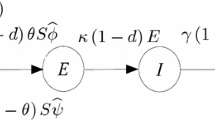Abstract.
A population with birth rate function B(N) N and linear death rate for the adult stage is assumed to have a maturation delay T>0. Thus the growth equation N′(t)=B(N(t−T)) N(t−T) e− d 1 T−dN(t) governs the adult population, with the death rate in previous life stages d 1≧0. Standard assumptions are made on B(N) so that a unique equilibrium N e exists. When B(N) N is not monotone, the delay T can qualitatively change the dynamics. For some fixed values of the parameters with d 1>0, as T increases the equilibrium N e can switch from being stable to unstable (with numerically observed periodic solutions) and then back to stable. When disease that does not cause death is introduced into the population, a threshold parameter R 0 is identified. When R 0<1, the disease dies out; when R 0>1, the disease remains endemic, either tending to an equilibrium value or oscillating about this value. Numerical simulations indicate that oscillations can also be induced by disease related death in a model with maturation delay.
Similar content being viewed by others
Author information
Authors and Affiliations
Additional information
Received: 2 November 1998 / Revised version: 26 February 1999
Rights and permissions
About this article
Cite this article
Cooke, K., van den Driessche, P. & Zou, X. Interaction of maturation delay and nonlinear birth in population and epidemic models. J Math Biol 39, 332–352 (1999). https://doi.org/10.1007/s002850050194
Issue Date:
DOI: https://doi.org/10.1007/s002850050194




